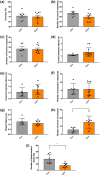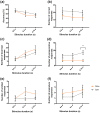Altered motor, anxiety-related and attentional task performance at baseline associate with multiple gene copies of the vesicular acetylcholine transporter and related protein overexpression in ChAT::Cre+ rats
- PMID: 31506825
- PMCID: PMC6875150
- DOI: 10.1007/s00429-019-01957-y
Altered motor, anxiety-related and attentional task performance at baseline associate with multiple gene copies of the vesicular acetylcholine transporter and related protein overexpression in ChAT::Cre+ rats
Abstract
Transgenic rodents expressing Cre recombinase cell specifically are used for exploring mechanisms regulating behavior, including those mediated by cholinergic signaling. However, it was recently reported that transgenic mice overexpressing a bacterial artificial chromosome containing choline acetyltransferase (ChAT) gene, for synthesizing the neurotransmitter acetylcholine, present with multiple vesicular acetylcholine transporter (VAChT) gene copies, resulting in altered cholinergic tone and accompanying behavioral abnormalities. Since ChAT::Cre+ rats, used increasingly for understanding the biological basis of CNS disorders, utilize the mouse ChAT promotor to control Cre recombinase expression, we assessed for similar genotypical and phenotypical differences in such rats compared to wild-type siblings. The rats were assessed for mouse VAChT copy number, VAChT protein expression levels and for sustained attention, response control and anxiety. Rats were also subjected to a contextual fear conditioning paradigm using an unconditional fear-inducing stimulus (electrical foot shocks), with blood samples taken at baseline, the fear acquisition phase and retention testing, for measuring blood plasma markers of hypothalamic-pituitary-adrenal gland (HPA)-axis activity. ChAT::Cre+ rats expressed multiple mouse VAChT gene copies, resulting in significantly higher VAChT protein expression, revealed anxiolytic behavior, hyperlocomotion and deficits in tasks requiring sustained attention. The HPA-axis was intact, with unaltered circulatory levels of acute stress-induced corticosterone, leptin and glucose. Our findings, therefore, reveal that in ChAT::Cre+ rats, VAChT overexpression associates with significant alterations of certain cognitive, motor and affective functions. Although highly useful as an experimental tool, it is essential to consider the potential effects of altered cholinergic transmission on baseline behavior in ChAT::Cre rats.
Keywords: 5-CSRTT; ChAT::Cre rats; Cre-recombinase; HPA endocrine axis; Touchscreen-based behavioral testing; Vesicular acetylcholine transporter.
Conflict of interest statement
The authors report no other biomedical financial interests or potential conflicts of interest.
Figures







Similar articles
-
Altered Baseline and Nicotine-Mediated Behavioral and Cholinergic Profiles in ChAT-Cre Mouse Lines.J Neurosci. 2018 Feb 28;38(9):2177-2188. doi: 10.1523/JNEUROSCI.1433-17.2018. Epub 2018 Jan 25. J Neurosci. 2018. PMID: 29371319 Free PMC article.
-
ChAT-ChR2-EYFP mice have enhanced motor endurance but show deficits in attention and several additional cognitive domains.J Neurosci. 2013 Jun 19;33(25):10427-38. doi: 10.1523/JNEUROSCI.0395-13.2013. J Neurosci. 2013. PMID: 23785154 Free PMC article.
-
VAChT overexpression increases acetylcholine at the synaptic cleft and accelerates aging of neuromuscular junctions.Skelet Muscle. 2016 Oct 5;6:31. doi: 10.1186/s13395-016-0105-7. eCollection 2016. Skelet Muscle. 2016. PMID: 27713817 Free PMC article.
-
Transient disturbances in contextual fear memory induced by Aβ(25-35) in rats are accompanied by cholinergic dysfunction.Behav Brain Res. 2014 Feb 1;259:152-7. doi: 10.1016/j.bbr.2013.11.013. Epub 2013 Nov 17. Behav Brain Res. 2014. PMID: 24257073
-
Alkylsulfones: novel chemical scaffolds targeting the vesicular acetylcholine transporter usher in a new generation of insecticides.Pest Manag Sci. 2025 May;81(5):2424-2426. doi: 10.1002/ps.8462. Epub 2024 Oct 5. Pest Manag Sci. 2025. PMID: 39367720 Review.
Cited by
-
Accumbens Cholinergic Interneurons Mediate Cue-Induced Nicotine Seeking and Associated Glutamatergic Plasticity.eNeuro. 2021 Feb 9;8(1):ENEURO.0276-20.2020. doi: 10.1523/ENEURO.0276-20.2020. Print 2021 Jan-Feb. eNeuro. 2021. PMID: 33239269 Free PMC article.
-
Gastric vagal afferent signaling to the basolateral amygdala mediates anxiety-like behaviors in experimental colitis mice.JCI Insight. 2023 Jun 22;8(12):e161874. doi: 10.1172/jci.insight.161874. JCI Insight. 2023. PMID: 37200091 Free PMC article.
-
The human VGLUT3-pT8I mutation elicits uneven striatal DA signaling, food or drug maladaptive consumption in male mice.Nat Commun. 2024 Jul 7;15(1):5691. doi: 10.1038/s41467-024-49371-1. Nat Commun. 2024. PMID: 38971801 Free PMC article.
-
Dissociable contributions of mediodorsal and anterior thalamic nuclei in visual attentional performance: A comparison using nicotinic and muscarinic cholinergic receptor antagonists.J Psychopharmacol. 2020 Dec;34(12):1371-1381. doi: 10.1177/0269881120965880. Epub 2020 Oct 24. J Psychopharmacol. 2020. PMID: 33103560 Free PMC article.
-
Characterization of social behavior in young and middle-aged ChAT-IRES-Cre mouse.PLoS One. 2022 Aug 4;17(8):e0272141. doi: 10.1371/journal.pone.0272141. eCollection 2022. PLoS One. 2022. PMID: 35925937 Free PMC article.
References
-
- Agnoli L, Mainolfi P, Invernizzi RW, Carli M. Dopamine D1-like and D2-like receptors in the dorsal striatum control different aspects of attentional performance in the five-choice serial reaction time task under a condition of increased activity of corticostriatal inputs. Neuropsychopharmacology. 2013;38:701–714. - PMC - PubMed
-
- Aldrin-Kirk P, Heuer A, Rylander Ottosson D, Davidsson M, Mattsson B, Björklund T. Chemogenetic modulation of cholinergic interneurons reveals their regulating role on the direct and indirect output pathways from the striatum. Neurobiol Dis. 2018;109:148–162. - PubMed
-
- Allison C, Shoaib M. Nicotine improves performance in an attentional set shifting task in rats. Neuropharmacology. 2013;64:314–320. - PubMed
MeSH terms
Substances
Grants and funding
LinkOut - more resources
Full Text Sources
Medical

